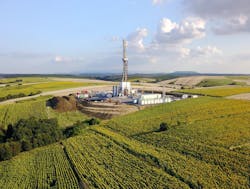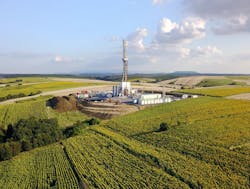Valeura testing basin-centered gas accumulation potential in Turkey
Valeura Energy Inc. of Calgary and partner Equinor started reservoir stimulation and testing operations on their Inanli-1 appraisal well in the Thrace Basin in northwest Turkey. Plans call for reservoir stimulation after diagnostic fracture injection testing and extended leakoff tests. Testing equipment, rated for up to 15,000 psi, was brought into Turkey from the US and Europe and set up for operations in late June.
Fig. 1 shows Valeura’s acreage, which is the source of both shallow, conventional production and its basin-centered gas accumulation (BCGA).
While Valeura and its predecessor companies have produced gas from shallow reservoirs in the Thrace basin for decades, the region has experienced very limited exploration for unconventional gas.
Through application of 3D seismic, basin-wide mapping, and investigating mineralogical similarities with analogous basins in North America, Valeura identified the potential for an unconventional gas accumulation on Thrace basin at deeper intervals than had been previously exploited. Valeura confirmed a BCGA play, made up of pervasive, basin-wide gas trapped at high pressure and high temperature in low-permeability rock.
With gas spread over a wide area, both laterally and stratigraphically, BCGA volumes can be significant, both for the companies who produce them and for the countries fortunate to have such an endowment.
Valeura’s unrisked working interest share of the Thrace basin BCGA prospective resources was evaluated by DeGolyer and MacNaughton of Dallas at 10.1 tcf equivalent of gas, including 236 million bbl of condensate.
BCGA plays are among the more economically important unconventional gas systems worldwide although BCGA exploration and production have been confined mainly to US and Canada, where the stratigraphic distribution extends from Cambrian through Eocene.
Turkey imports nearly all the gas that it uses so development of domestic unconventional gas could lessen the country’s dependence on imports from Russia, Azerbaijan, and elsewhere. Valeura and Equinor are trying to find zones that sustain a commercial gas flow.
The Banarli and West Thrace licenses together cover 1,200 sq km. The acreage is near infrastructure in an area where gas has been produced since the 1970s. Valeura built a pipeline to connect the wells being tested to its preexisting infrastructure for transportation onto market.
Valeura Energy holds interest in 20 production leases and exploration licenses reaching across Thrace basin, which covers 460,000 acres gross.
Equinor holds 50% interest in formations deeper than 2,500 m within the Banarli and West Thrace licenses. Valeura holds 50% in the deep formations in the Banarli license, and 31.5% in the deep formations in the West Thrace. Pinnacle Turkey holds 18.5% in West Thrace.
Valeura in 2018 produced an average of 4.3 MMcfd of natural gas from conventional accumulations in its shallower rights.
Yamalik-1 discovery
Valeura drilled Yamalik-1 discovery well to 4,200 m in 2017 (Fig. 2). The well discovered a 1,300-m natural gas and condensate column in overpressured reservoirs below 2,900 m in the Tertiary Teslimkoy and Kesan formations. Shallower Mezardere and Osmancik reservoirs have not been tested.
Crews drilled the Inanli well to 4,900 m just east of Yamalik and moved 20 km over to drill the Devepinar-1 to 4,800 m. Devepinar-1 encountered a 1,066-m gas column. All three high-pressure, high-temperature wells had the same reservoir target.
As of June 2019, Valeura expected to stimulate 8 up to 12 zones between Yamalik-1, Inanli-1, and Devepinar-1. The program is designed to maximize data capture and identify zones that warrant additional evaluation through drilling.
Because of Thrace’s varied geology, Valeura will test zones individually. The work could lead to a pilot development involving a multi-well pad and horizontal wells. More vertical wells likely will be drilled. To date, 11 vertical wells demonstrated a laterally continuous objective, according to Valeura.
“Our recent penetrations have drilled up to 1 mile of continuous gross gas column,” said Sean Guest, Valeura president and chief executive officer. “Our near-term focus is shifting squarely to production testing multiple zones to understand the gas flow characteristics of our reservoir, both vertically and laterally.”
Inanli-1 appraisal
Crews ran diagnostic fracture injectivity tests (DFIT) to confirm high downhole pressures interpreted from mud weights during Inanli-1 drilling. The lowest DFIT at 4,813 m confirmed a pressure gradient of 0.809 psi/ft, similar to Yamalik-1 results.
A second extended DFIT on a specific completion zone established formation fracture stimulation parameters and pore pressure before reservoir stimulation operations.
Deepest zones will be completed first and shallower sweet spots will be tested later. In most cases, only a single fracture stimulation will be completed in each zone to allow flow properties to be directly correlated to target reservoirs, which will help calibrate the petrophysical data already acquired.
The length of the test on each zone will be determined by how well it flows, but flow periods will be longer than the Yamalik-1 completion. Different tracers will be used in the fracturing fluids to allow better monitoring of fluid flowback during testing and to determine if a comingled flow is to be attempted after the individual zonal testing.
Equinor will carry the costs for the Inanli-1 stimulation and testing will complete their earning obligations under the Banarli farm in agreement.
Devepinar-1 appraisal
Crews drilled Devepinar-1 appraisal well about 500 m deeper than originally planned due to significant gas shows and faster drilling penetration rates, encountering the top of the objective reservoir at 3,730 m. A gross 1,066-m column is interpreted to be gas-bearing down to about 4,800 m. During drilling, formation gas was circulated to the surface and flared several times. Much of the deep drilling involved mud weights in excess of 0.78 psi/ft to manage gas inflow.
The well confirmed an overpressured, gas-bearing reservoir at the western flank of the mapped basin-centered gas accumulation (BCGA), which is a pervasive, basin-wide gas accumulation trapped in low-permeability rock.
Devepinar-1 log data and higher-than-expected penetration rates indicated higher porosity at Devepinar-1 than Inanli-1 and Yamalik-1 at similar depths. Results increased understanding of the lateral extent of the reservoir and occurrence of over-pressure related to Valeura’s basin-wide play mapping.
Devepinar-1 has multiple zones with the best zones in the upper Kesan formation. The well was cased and left ready for testing and completion.
Valeura and Equinor are assessing potential intervals before developing a reservoir stimulation program to be operated by Valeura.
Near-term operations
Over-pressured gas extends down almost 5,000 m. Recent appraisal wells are up to 20 km apart to evaluate up to 1 mile of vertical objective reservoir.
Testing of the Inanli-1 and Devepinar-1 wells will provide data on reservoir zones at varying depths, pressures, fracture density, hydrocarbon maturities, and reservoir quality.
Flow data will be used to select additional drilling locations and determine which zones should be chosen for horizontal development well targets.
By applying 3D seismic, stimulation technology, and drilling horizontal wells as well as deeper vertical, Valeura expects to produce tight gas.
About the Author
Paula Dittrick
Senior Staff Writer
Paula Dittrick has covered oil and gas from Houston for more than 20 years. Starting in May 2007, she developed a health, safety, and environment beat for Oil & Gas Journal. Dittrick is familiar with the industry’s financial aspects. She also monitors issues associated with carbon sequestration and renewable energy.
Dittrick joined OGJ in February 2001. Previously, she worked for Dow Jones and United Press International. She began writing about oil and gas as UPI’s West Texas bureau chief during the 1980s. She earned a Bachelor’s of Science degree in journalism from the University of Nebraska in 1974.



